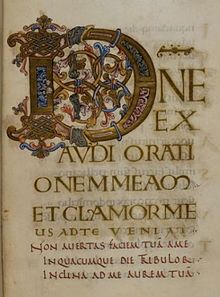Ramsey Psalter


The Psalter of Oswald also called the Ramsey Psalter (
The
The text is a
The two most famous illuminated pages are at the start of the manuscript and are illustrated here and discussed below. Apart from another very large illuminated initial at the start of Psalm 101, the rest of the illumination consists of smaller decorated initials with colour at the start of each psalm, and gold initials for each verse.[4]
Illumination
Unsurprisingly for a manuscript with such strong connections to Oswald, a leader of the
The artist of the Crucifixion miniature seems also to have worked at Fleury Abbey, where both Oswald and his uncle, Archbishop Oda of Canterbury, had trained,[7] as well as the Abbey of Saint Bertin, Saint-Omer, both of these in France. At St Bertin he worked on the Boulogne Gospels (municipal library there, MS 11) and at Fleury on the Harley Aratea (BL, Harley MS 2506).[8]
The figure of Christ is very similar to that on an Anglo-Saxon reliquary cross in the Victoria and Albert Museum, which was set on a small reliquary in Germany around 1000.[9] The Beatus initial appears to be the first to use the "lion-mask" in the bridge,[10] which was to be widely copied in England and abroad.[11]
Notes
- ^ Brown, 119
- ^ BL
- ^ Brown, 120
- ^ BL
- ^ Backhouse, Turner and Webster, 60
- ^ Pächt, 86
- ^ Backhouse, Turner and Webster, 60
- ISBN 0300064934
- ^ Wilson, David M.; Anglo-Saxon Art: From The Seventh Century To The Norman Conquest, pp. 194-195, Thames and Hudson (US edn. Overlook Press), 1984.
- ISBN 9780714128092; Brown, 119; for example there is a mask in the very similar drawn Beatus initial in the Winchcombe Psalter, Cambridge University Library, MS Ff.1.23, f. 5, dated 2nd quarter of the 11th century, see: Backhouse, Turner and Webster, 78 and illustrated at 80.
- ^ Pächt, 86-89
References
- L. Webster, eds.: The Golden Age of Anglo-Saxon Art, 966-1066. London: British Museum, 1984.
- British Library: Detailed record for Harley 2904 in the BL Catalogue of illuminated manuscript (with several images and bibliography).
- ISBN 9780712306805, p. 119.
- Otto Pächt: Book Illumination in the Middle Ages: an introduction. London: Harvey Miller, 1986. ISBN 0199210608.
Further reading
- Holcomb, M. (2009). Pen and Parchment : Drawing in the Middle Ages. New York: The Metropolitan Museum of Art. (see index)
External links
- images on ramseyabbey.co.uk
- The Great Benedictine Abbey of Ramsey
